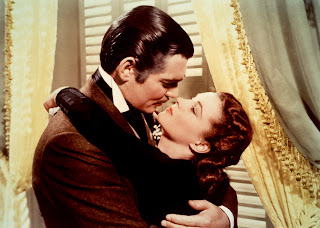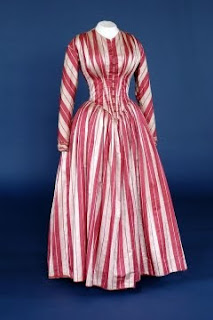>
 Read this article on CNN.com before you read my blog: http://www.cnn.com/2009/OPINION/12/15/haskell.gone.with.the.wind/index.html
Read this article on CNN.com before you read my blog: http://www.cnn.com/2009/OPINION/12/15/haskell.gone.with.the.wind/index.html
I suppose I must have been living in the safe little bubble of historians and the like since I was a child because I never really knew there was controversy today about Gone with the Wind and its portrayal of African-Americans. It seems as the generations and social development put distance between us and the socioeconomic atmosphere of the nineteenth century, fewer and fewer people are able to accept that African-Americans were segregated, treated less than human, and so on. According to the law of the period, a slave was only counted as one-third of a person. Up until the mid-twentieth century, the children and grandchildren of slaves were segregated from white society and generally treated like garbage. African-American actors and actresses were not exempt from this segregation, nor were they given parts beyond the scope of service to the white lead actors. We all know this to be true and I knew this growing up in St. Louis.
However, I was surprised to read today that people cannot stomach the African-American actors being limited to roles as slaves in Gone with the Wind and also being portrayed as indifferent or even okay with their slave statuses. Well, let me rephrase. I was surprised, as a historian, to see that sort of outrage but then I reminded myself that I have been so engrossed in the nineteenth century for my entire life that I have a solid understanding of the mentality of that period that most people do not. I totally understand the outrage over the racism from a modern perspective. Believe me, I would never condone slavery or racism in any form. That does not, however, change the fact that it happened and if historical movies are going to be made, the history and mentality of the people in any period should not be watered down or revised. I think most of the people who express outrage and hatred toward Gone with the Wind want to pretend like slavery never happened or want to ignore the fact that not all slaves were ready to kill their masters and escape to freedom. From our modern perspective, we can’t understand how an enslaved human being would not fight for freedom. But it happened, quite a bit more than people think.
I have read quite a few firsthand accounts from former slaves. In the 1930s, reporters began recording and collecting their stories. What I found is that the Uncle Tom’s Cabin (a fictional novel that has shaped people’s view of slavery) story of horrible cruelty, physical violence and so on was not the norm. It was the minority. This is not to say slaves didn’t dream about, crave or desire their freedom, even if their masters treated them well. From what I can tell, most slaves behaved in a subdued manner, somewhat protective of the white family, and there was an undercurrent of their own society where they spoke more freely in their own quarters. So while Mammy, Pork and the rest of the Gone with the Wind slaves appeared satisfied with their lives, there was no backstory on them so we can’t know what they were thinking behind the scenes. Gone with the Wind was written by a Southern white woman, only a generation or two removed from slavery. It was indoctrinated in white people from birth that slaves were a necessity of life, an amenity, a functional piece of furniture, and so on. The majority of white slaveholders were not paying attention to the undercurrents of slave society and what they were really thinking about their bondage. To use an analogy, a person in an abusive relationship is going to do everything possible to please the abuser in order to prevent the abuse. Of course a slave was not going to display his or her displeasure or hatred of their life in front of the people who control their food, clothing and shelter. White families often wondered why their slaves ran away because they felt they were taking care of their slaves and they could not compute the immorality of slavery or how someone would want to run away if food, clothing and shelter was being provided.
This is not to say Gone with the Wind is an accurate portrayal of that period, but in the case of the slavery question, you have to look beneath the surface and look deeper into the complex and layered social and economic life of the plantation system. None of it was black and white (please excuse the pun), even in the North. In truth, freed African-Americans in the North had harder lives than slaves in the South. I am NOT defending slavery, however. I am encouraging people to look deeper into these issues before snap judgments arise. For example, the “Great Emancipator” Abraham Lincoln is remembered today as a great champion of racial equality but the truth is if you look at his writing through modern eyes, he sounds like a raving white supremacist. One of the solutions he proposed to the slavery question was to take all of the freed African-Americans either back to Africa (even though the slave trade ended years before and most slaves by the 1860s had never seen Africa) or totally segregate the African-American population from the white population. He did not believe in mixing races even though he disagreed with slavery.
Abraham Lincoln was an average man for his time but he would be considered a raving racist for our time. So when you look at people in history, you have to look at their world through their eyes. The outrage comes because people are looking at the past through modern eyes. There is absolutely no justification for slavery or racism but watering it down, ignoring it or revising it without understanding how complicated the plantation system was is not doing history justice either. Gone with the Wind is a story written by a Southern white woman. Of course it’s going to favor the Southern white class. To her, it probably was accurate because the pretense of docile subdued loyal slaves are probably all her grandparents saw or chose to see.
The part about the controversy of Gone with the Wind that bothers me the most is that everybody is up in arms about the slavery and racism but nobody even raises an eyebrow about the fact that Rhett raped Scarlett. Remember the part when both of them were drunk and fighting and Rhett carried Scarlett upstairs against her will, then the next morning apologized? That’s as close as 1939 film making could get to depicting rape. Nobody seems to be up in arms about the rape, probably because people are all so distracted by the Rhett Butler swagger and sex appeal.
White women were a step above slaves and a step below white men if you want to get technical and historical. If a white man chose to take a slave mistress (or any other mistress, really), for example, the white wife could not say anything about it. Imagine living in your plantation home basically cut off from the nearest town by distance and no ability to go out unescorted. Imagine being aware that your husband was sleeping with your maid but you had to coexist with her. You couldn’t fire her because she was your husband’s property. You couldn’t leave because your husband, under the law, technically owned your possessions, money, property and children. You had no rights. Your husband was your sole provider and your duty was to obey him and coexist with the house slaves, uncertain of which ones he was using for his pleasure. White women and slave women, at times, had a lot more middle ground than people today think.
I told you the plantation system was complex. Gone with the Wind is just a story and does not depict the full scope of life in the Civil War and Reconstruction.
Read More












